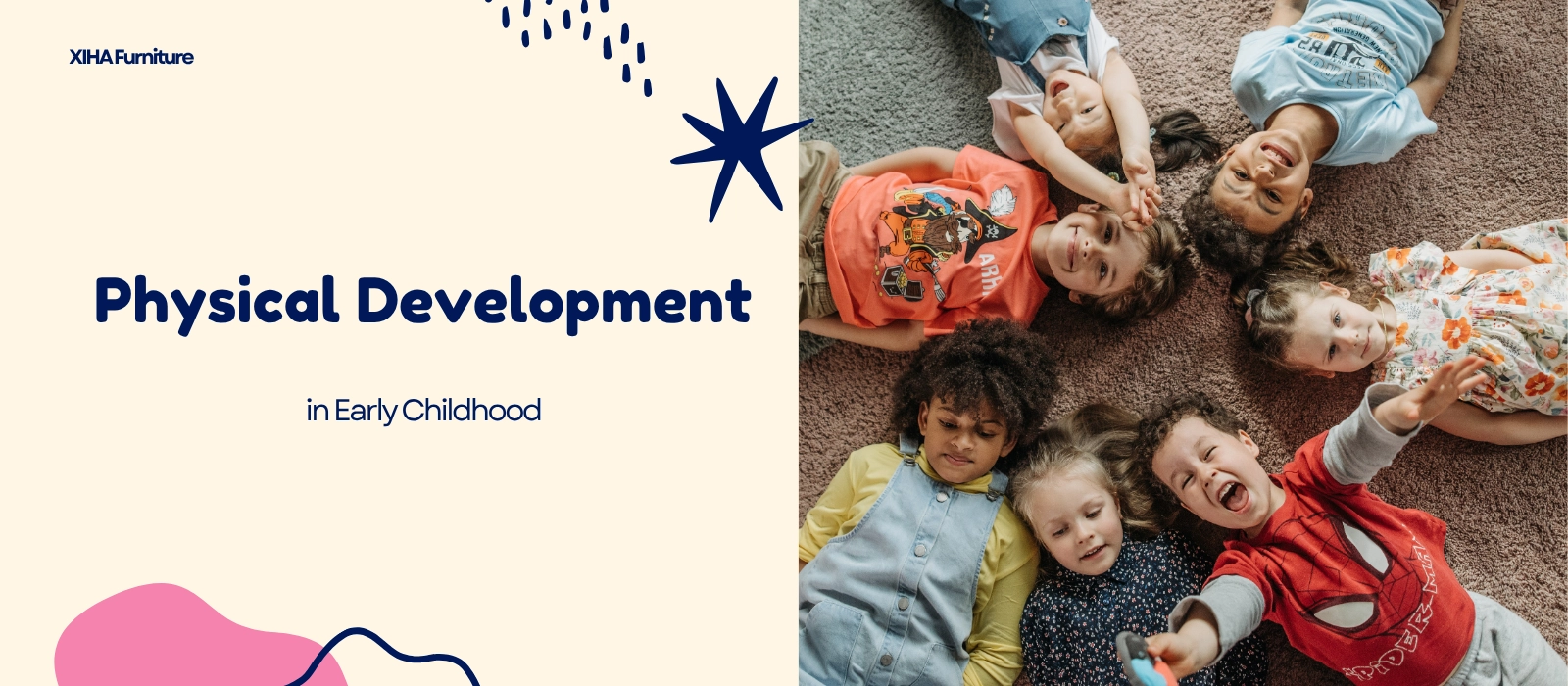Are you worried your child isn’t running, jumping, or climbing like other kids? Have you ever wondered if delays in movement could mean something deeper? Do preschool teachers struggle to keep children physically engaged throughout the day? These questions often highlight hidden concerns about physical development in early childhood—a domain too critical to be overlooked.
Physical development in early childhood isn’t just about learning to walk or throw a ball—it’s the biological and behavioral foundation for lifelong learning, social participation, and emotional wellbeing. From gross motor skills like balancing and climbing, to fine motor precision used in writing and art, a child’s physical capabilities directly influence their confidence, communication, and cognitive performance. In early childhood education, recognizing and supporting physical development is essential for nurturing the whole child.
Physical development defines much of how young children experience and interact with the world around them. When a child learns to balance, jump, or manipulate objects with their hands, they’re not just becoming stronger or more agile—they’re also laying down neural pathways that support problem-solving, memory, and even emotional regulation. In this article, I’ll take you deep into the stages, domains, milestones, and methods that make physical development in early childhood one of the most vital aspects of human growth.
1. What Is Physical Development in Early Childhood?
Physical development in early childhood refers to the progression of bodily growth, movement skills, and motor control that occur between birth and around age eight. These foundational years shape how a child moves, explores, and interacts with the environment. From the moment infants begin to roll over and grasp objects, they embark on a continuous journey through major developmental milestones, with each one signaling the maturation of specific systems within the physical domain of development.
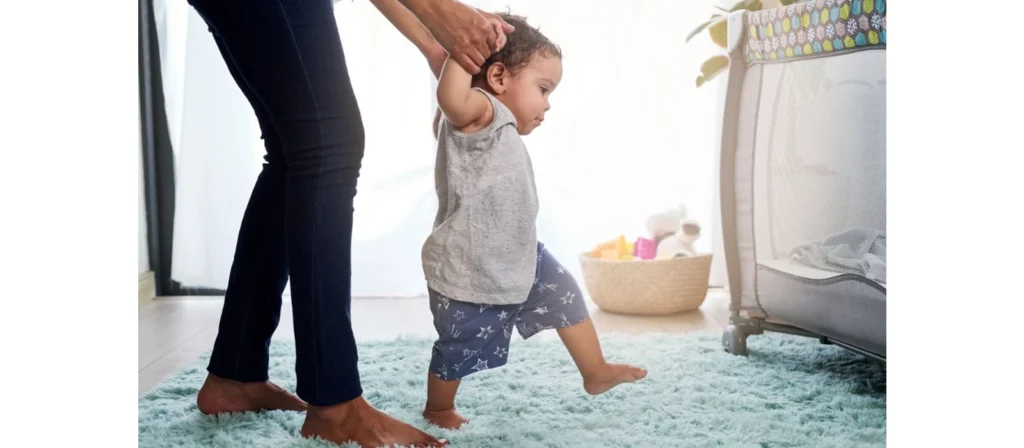
At the core, physical development is often divided into gross motor skills and fine motor skills. Gross motor skills involve larger muscle groups used in crawling, walking, running, and jumping. Fine motor skills, on the other hand, require coordination of smaller muscles, such as those controlling the hands and fingers—essential for writing, buttoning clothes, and feeding themselves. Both types of movement are central to a child’s autonomy, self-esteem, and ability to participate in structured learning and play.
Physical development in early childhood also ties deeply into the developmental domains outlined by child development specialists. These include the cognitive domain, social and emotional domain, language domain, and approaches to learning. Research consistently shows that physical development isn’t isolated; instead, it enhances or restricts progress in the other domains. A child who struggles with physical coordination might find it harder to engage socially or concentrate during classroom activities, leading to delays across the board.
According to the American Academy of Pediatrics, the ability to identify physical development delays early allows for timely interventions, which can drastically improve outcomes later in life. Regular monitoring through tools like the developmental milestones chart, parent-teacher observations, and pediatric checkups is crucial. These efforts ensure children are on track and allow caregivers to better understand the levels of development typical for the early childhood age range.
In educational psychology, physical development is sometimes discussed within the psychomotor domain, which includes both reflexive movements and learned physical actions. In preschool settings, structured play, outdoor activities, and hands-on classroom exercises form the bedrock for strengthening this domain. This highlights why physical development in early childhood is not just about fun and games—it’s an educational priority.
The importance of physical development is also emphasized in the NAEYC developmentally appropriate practices framework. It stresses that supporting children’s physical growth means designing environments and activities tailored to each developmental level, allowing children to develop at their own pace while still being gently guided forward.
In essence, physical development in early childhood is the first and most observable indicator of healthy growth. As educators, caregivers, or program directors, we must understand its definitions, recognize its patterns, and implement strategies that foster safe, comprehensive development across all types of development. This knowledge equips us to provide better early childhood environments that prepare children for the complex physical, intellectual, and emotional demands of life.
2. Why Physical Development in Early Childhood Matters
Physical development in early childhood is not only a visible sign of growth but a core building block of a child’s ability to function and flourish in multiple developmental domains. Without adequate physical abilities, children can struggle with tasks that involve concentration, social cooperation, and communication. The importance of this area is often underappreciated until delays become obvious. Let’s look deeper into why this domain holds such weight in early childhood education.
Physical Development Supports Learning Across All Domains
Children who develop strong motor skills tend to perform better in academic settings. Their ability to sit upright, hold a pencil, or participate in hands-on activities all stem from early physical competencies. These foundational skills impact progress in the cognitive domain, including problem-solving and memory retention. Even attention span is affected by posture and core strength, which are parts of the physical development process.
Movement Enhances Brain Development
Studies show that physical activity boosts brain function in young children. As they run, jump, and climb, new neural connections form in areas responsible for executive function and spatial awareness. Physical development in early childhood is therefore linked to improved learning readiness, especially in tasks that require sequencing and critical thinking. Activities that blend movement and learning—like obstacle courses or music-based movement—are especially beneficial.
Physical Health Is Tied to Emotional Wellbeing
Children who feel strong and capable in their physical bodies often display higher levels of confidence. This contributes to better emotional regulation and social engagement. On the other hand, children with delayed physical development may withdraw from group activities, leading to reduced interaction and lower self-esteem. That’s why physical development must be addressed alongside emotional and social domains.
Early Detection and Support Are Crucial
If a child is lagging behind in reaching key developmental milestones, early intervention can make a significant difference. Programs focused on pediatric developmental stages stress the need for constant observation, especially between ages 2–6. The earlier challenges in the physical domain are identified, the more effective the strategies to correct them.
Supporting physical development in early childhood isn’t just a matter of physical health—it’s a holistic investment in a child’s total growth. Whether we’re educators, curriculum planners, or parents, understanding the importance of physical development allows us to build stronger foundations for all future domains of learning.
3. Key Physical Development Milestones by Age
Understanding the key physical development milestones by age helps parents, educators, and healthcare providers track whether children are progressing typically. While individual development can vary, most children follow a predictable pattern of physical skills that align with their age. These skills fall within both gross and fine motor domains and are central to daily function, learning, and play.
Infancy (0–12 months)
In the first year of life, rapid physical changes occur. Infants begin with basic reflexes and gradually gain control over their head, torso, and limbs. Typical milestones include:
- Lifting the head during tummy time (around 2 months)
- Rolling over from front to back (4–6 months)
- Sitting up without support (6–8 months)
- Crawling or scooting (7–10 months)
- Pulling to stand and cruising along furniture (9–12 months)
These actions represent early gross motor milestones in pediatric developmental stages and lay the groundwork for walking and balance.
Toddlerhood (1–3 years)
This is the stage of exploration. Physical development accelerates with walking, running, and increased coordination. By age three, many toddlers can:
- Walk independently and change direction quickly
- Run short distances and avoid obstacles
- Climb stairs with assistance
- Stack blocks and turn book pages
- Feed themselves with a spoon or fork
These milestones represent both gross and fine motor skills. Delays in walking or inability to use fingers effectively might indicate developmental issues that require professional attention (CDC Developmental Milestones – external link).
Preschool Age (3–5 years)
During the preschool years, physical skills become more refined. Children in this age group show noticeable progress in both strength and coordination. Key milestones include:
- Jumping with both feet and hopping on one foot
- Catching, kicking, and throwing balls with more accuracy
- Using scissors to cut along a line
- Drawing simple shapes and writing some letters
- Dressing and undressing independently
This stage is especially critical for early childhood programs like Imagine Preschool or Montessori models, where physical activities are integrated into learning routines.
Early School Age (5–7 years)
As children enter school, their physical development supports more complex tasks. They gain endurance and precision, which support formal learning. Common abilities at this stage include:
- Balancing on one foot for 10+ seconds
- Riding a bicycle with training wheels
- Writing full sentences and tying shoelaces
- Increased participation in team sports or structured games
By this point, physical development in early childhood intersects deeply with cognitive and emotional growth, reinforcing the importance of balanced domains of development.
Tracking these physical development milestones is essential for early identification of challenges. Pediatricians and educators often use standardized milestone charts to monitor progress and identify needs for support services. Timely recognition of these signs allows for targeted interventions, giving every child the best chance to thrive in all developmental domains.
4. The Core Domains of Physical Development
Understanding the core domains of physical development in early childhood is essential for designing effective educational programs, environments, and interventions. This stage of life is shaped by a variety of interconnected physical processes that lay the groundwork for both academic and personal success.
Gross Motor Development
Gross motor skills involve the use of large muscle groups that control movements such as crawling, standing, walking, jumping, and climbing. These are the skills most often associated with playground activity and physical education. The development of gross motor skills is fundamental for children’s participation in group games, sports, and even basic classroom behaviors like sitting still or lining up. Activities that promote gross motor skill development include:
- Running obstacle courses
- Jumping games
- Climbing playground structures
- Balance exercises using beams or stepping stones
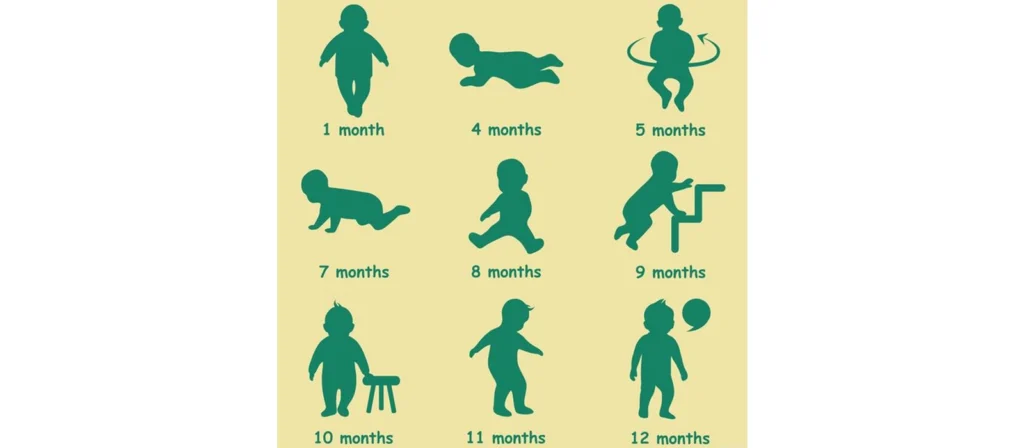
Children with delayed gross motor development may be flagged for additional evaluation through developmental milestones assessments or referrals to pediatric physical therapists.
Fine Motor Development
Fine motor skills involve the coordination of small muscles, particularly in the hands and fingers. These skills are necessary for tasks such as writing, buttoning clothes, tying shoes, and manipulating classroom tools like scissors and pencils. Fine motor development tends to mature slightly later than gross motor skills but is equally important for school readiness and self-care independence. Milestones in this area include:
- Drawing lines, circles, and basic shapes
- Picking up small objects with fingers
- Turning pages of a book
- Cutting along a straight line with scissors
Supportive activities might include playdough modeling, threading beads, using tweezers, and arts-and-crafts projects that strengthen hand muscles.
Sensory-Motor Integration
Physical development also involves the ability to process sensory information and coordinate appropriate physical responses. Known as sensory-motor integration, this function is critical for spatial awareness, hand-eye coordination, and reaction time. Children who struggle in this area may appear clumsy, overly sensitive to textures or noise, or have difficulty following multi-step physical instructions. Occupational therapists often support children whose developmental domains include sensory processing disorders.
Postural Control and Core Stability
A less discussed but equally vital aspect of physical development in early childhood is postural control. Children need strong core muscles to maintain upright posture during activities such as sitting, standing, and writing. Poor postural control can interfere with focus and stamina, leading to behavioral challenges and reduced academic performance.
All these domains within physical development are interconnected and play a role in achieving age-appropriate developmental milestones. When any one domain lags behind, it can affect the others—highlighting the importance of holistic developmental support strategies in early education environments. By recognizing the diversity and significance of each physical development domain, educators and caregivers can better tailor interventions and encourage balanced growth across all levels of development.
5. Interplay Between Physical and Cognitive Development in Early Childhood
Physical development in early childhood doesn’t just influence how children move—it shapes how they think, process information, and solve problems. The connection between movement and mental function is well-documented across educational and developmental psychology fields. Children’s ability to coordinate their bodies is directly linked to how they develop memory, attention, spatial awareness, and even language skills.
Physical Activity Boosts Brain Development
Research from the Harvard Center on the Developing Child shows that early physical experiences actively shape brain architecture. As children engage in crawling, walking, running, and climbing, they stimulate the growth of neural connections in the brain, particularly in regions responsible for executive functions such as planning, regulation, and flexible thinking.
Preschool activities that encourage movement—like obstacle courses, action songs, and nature walks—also enhance sensory integration and cognitive sequencing. These tasks require the brain to process information, plan a response, and carry it out with physical precision. It’s a cycle of learning through doing, reinforcing the importance of physical development in early childhood.
Motor Skills and Academic Readiness
Fine motor development, such as holding a pencil or using scissors, directly affects school readiness. Children who struggle with these skills often fall behind in academic tasks like writing or drawing. Likewise, gross motor skills such as sitting upright with stability influence how long a child can focus or participate in classroom discussions. A child’s physical capability to engage fully in school is often a silent determinant of their academic progress.
Moreover, physical activity has been shown to improve attention span and memory retention—two core components of the cognitive domain. Programs that integrate physical movement into academic learning, such as “move-to-learn” strategies, are particularly effective in preschool and early primary education.
Spatial Reasoning and Physical Exploration
When children navigate space—whether through climbing, jumping, or manipulating objects—they’re developing critical spatial reasoning skills. These abilities form the foundation for later learning in subjects like mathematics, geometry, and science. Manipulative play, such as using blocks or puzzles, bridges the physical and cognitive domains by fostering visual-motor integration.
In sum, the interplay between physical development in early childhood and cognitive development is reciprocal and reinforcing. Physical experiences create pathways in the brain that enhance higher-order thinking, and cognitive tasks often require a physical component for mastery. Educators and parents must recognize that nurturing motor development is not separate from fostering intellectual growth—it is, in fact, an essential component of it.
6. Physical Development Activities for Preschoolers
Providing developmentally appropriate physical activities for preschool-aged children plays a pivotal role in strengthening physical development in early childhood. These activities enhance both gross and fine motor skills, supporting the physical domain and reinforcing all five developmental domains essential for early learning.
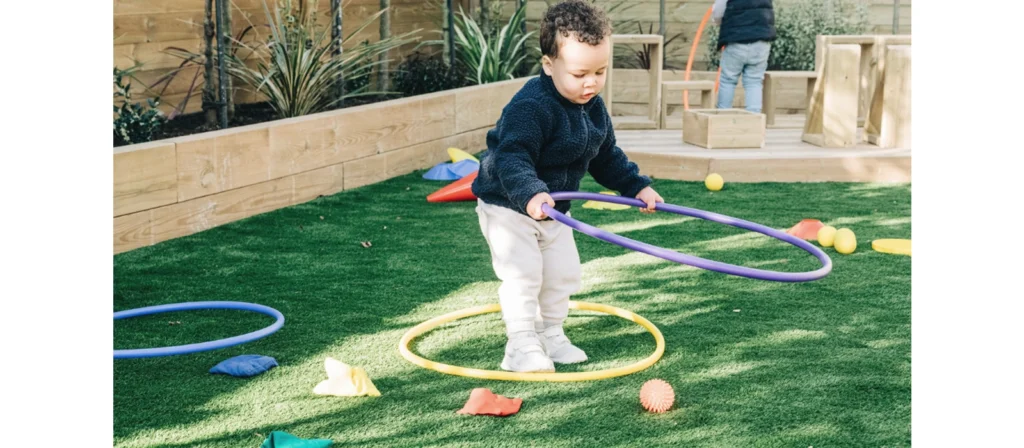
Structured Movement Activities
Structured physical activities directly support physical development in early childhood by helping children gain motor control, body coordination, and social interaction skills. Examples include:
- Obstacle courses using cones, tunnels, and balance beams
- Circle games like “Duck Duck Goose” or “Simon Says”
- Relay races that incorporate hopping, crawling, or balancing
- Follow-the-leader routines to build movement sequencing
These organized activities improve balance, strength, and coordination, all of which are critical for meeting physical development milestones in early childhood programs.
Free Play and Outdoor Exploration
Allowing children to engage in unstructured outdoor play stimulates their physical development in early childhood by giving them freedom to explore, climb, jump, and manipulate objects. Activities include:
- Building forts or nature shelters
- Playing tag and chasing games
- Sand and water sensory stations
Such play helps reinforce spatial awareness, sensory-motor integration, and muscle development, which are all foundational to childhood physical growth.
Fine Motor Activities in the Classroom
To support physical development in early childhood, especially the fine motor aspect, preschool classrooms should include activities such as:
- Lacing beads and using pegboards
- Tearing paper and crafting
- Drawing letters, shapes, and using stamps
These tasks improve hand-eye coordination, pencil grip, and finger strength—key indicators of fine motor development in the early childhood stage.
Mind-Body Connection Activities
Activities that blend movement with mindfulness deepen physical development in early childhood by reinforcing body awareness, posture, and concentration. Effective examples include:
- Story-driven yoga stretches
- Breathing and movement sequences
- Dancing to rhythmic instructions
These practices support emotional regulation while fostering core stability, both of which are linked to long-term physical and psychological health.
Educators and parents alike should prioritize physical development in early childhood throughout the daily schedule. Integrating gross motor games, fine motor tasks, and movement-based mindfulness ensures that children build a solid foundation for physical confidence, academic readiness, and holistic development. Every aspect of a preschooler’s routine should reinforce the importance of physical development in early childhood.
7. Factors That Influence Physical Development in Early Childhood
Several key factors influence the pace and quality of physical development in early childhood. While some of these are innate or biological, many are shaped by the environment, educational opportunities, and even emotional support systems. Understanding these variables can help caregivers and educators create ideal conditions for promoting consistent physical development in early childhood.
Nutrition and Physical Growth
Nutrition is a foundational element of physical development in early childhood. Without adequate intake of essential nutrients—especially protein, calcium, iron, and vitamins A, D, and C—children may experience stunted growth, delayed motor development, and fatigue that limits activity. Healthy eating habits, balanced diets, and proper hydration directly support the strength and endurance needed to achieve gross and fine motor milestones.
Children who are malnourished may struggle to meet expected benchmarks in the physical domain of development, highlighting the need for integrated nutrition programs in early childhood settings.
Health and Medical Conditions
Health issues such as asthma, frequent infections, or congenital disorders can significantly impede physical development in early childhood. Chronic conditions may reduce a child’s energy levels or mobility, impacting their ability to participate in age-appropriate movement activities. Routine health screenings, immunizations, and pediatric assessments help ensure early detection and intervention.
Pediatricians often rely on standardized developmental milestones and child growth charts to track physical development in early childhood and identify concerns at the earliest stages.
Environmental Stimulation and Access to Play
A stimulating and safe environment is critical for supporting physical development in early childhood. Children who have access to open play spaces, varied equipment, and structured physical routines develop faster and with more confidence. Whether indoor play areas with child-sized furniture or outdoor parks with climbing frames, consistent access to active play encourages exploration and motor skill refinement.
Studies show that environments rich in physical and sensory stimulation accelerate development across multiple domains, reinforcing the strong ties between physical development in early childhood and the broader educational setting.
Emotional Wellbeing and Support
Emotional security and caregiver involvement also influence physical development in early childhood. Children who feel safe and supported are more likely to take physical risks—like climbing higher, trying new sports, or using new tools. This trial-and-error approach is essential for building strength, balance, and coordination.
Furthermore, stress and trauma can negatively affect physical development by interfering with appetite, sleep, and motivation to move. Emotional wellness supports overall physical growth and helps children regulate their bodies and behaviors effectively.
Promoting healthy physical development in early childhood requires a holistic approach. From nutrition and medical care to emotional security and play-based learning environments, every element of a child’s daily life contributes to their physical capabilities. By understanding these influencing factors, educators and caregivers can take informed steps to optimize every child’s developmental journey.
8. Assessing Physical Development: Tools and Indicators
Effectively tracking physical development in early childhood requires the use of well-established tools and clear indicators. Assessment helps identify whether a child is developing within expected parameters or may need additional support. Accurate, regular monitoring ensures that both fine and gross motor milestones are being met and can inform personalized teaching strategies.
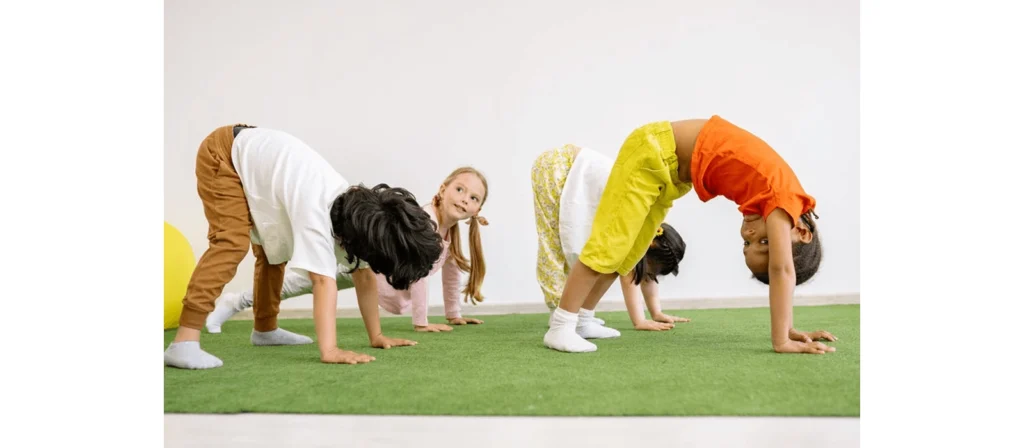
Developmental Milestone Charts
Milestone charts are among the most commonly used tools for evaluating physical development in early childhood. These charts, such as those provided by the Centers for Disease Control and Prevention, list typical motor achievements by age—rolling over, sitting up, walking, running, jumping, etc. Caregivers and educators can use them as quick references to determine if children are meeting age-appropriate goals.
Developmental milestone charts also help track progress in fine motor skills like grasping crayons, stacking blocks, and using scissors, all of which are key indicators of physical development in early childhood.
Pediatric Developmental Screenings
Pediatricians use structured tools during routine checkups to assess physical development. These screenings often include parent questionnaires, hands-on motor tests, and growth measurements. Instruments like the Ages and Stages Questionnaire (ASQ) or the Denver Developmental Screening Test offer insight into whether a child’s development is on track across multiple domains—including the physical domain.
Screenings also allow early identification of developmental delays or disorders, enabling timely referrals to specialists such as physical or occupational therapists.
Teacher Observation and Documentation
In early childhood classrooms, teacher observation remains a powerful and practical tool for assessing physical development. Educators often use checklists and anecdotal notes to record behaviors during play and learning activities. For instance, a teacher might note a child’s progress in balancing on one foot, climbing a ladder, or manipulating small objects.
Daily routines such as snack time, outdoor play, or art sessions provide natural opportunities to observe physical development in early childhood without disrupting learning. These observations contribute to individualized education plans and parent-teacher discussions.
Portfolios and Progress Reports
Another valuable tool is the development of student portfolios. These may include photos, work samples, drawings, and narrative summaries that document growth in physical ability over time. Progress reports generated from such portfolios provide clear visual and written evidence of developmental gains across preschool months or years.
Effective assessment is a critical component of supporting physical development in early childhood. It ensures that no child falls behind and that interventions are timely, appropriate, and grounded in real-world observations. Whether through milestone charts, pediatric screenings, or teacher notes, assessment tools guide caregivers and educators in nurturing every child’s full physical potential.
9. Integrating Physical Development into Preschool Curriculum
Successfully integrating physical development in early childhood into preschool curriculum design ensures that children receive balanced educational experiences across all developmental domains. Physical activity should not be treated as a separate element but instead woven into daily routines, thematic lessons, and classroom culture.
Embedding Movement in Daily Routines
Routine activities offer excellent opportunities for reinforcing physical development in early childhood. Teachers can incorporate motor activities into arrival routines, transitions, and circle time. For example:
- Morning stretches before group time
- Movement songs during story sessions
- Physical games between activity stations
This frequent, purposeful movement supports attention, behavior regulation, and readiness to learn.
Thematic Learning with Physical Components
Preschool curriculum units centered around themes—such as nature, transportation, or community helpers—can include movement-based tasks that target gross and fine motor skills. A “construction” unit might feature building with blocks and dramatic play with tools, enhancing hand strength and coordination. A “weather” unit might include jumping over puddles (real or pretend), reinforcing balance and leg strength.
Using physical development in early childhood as a cross-cutting theme enhances multisensory learning, making abstract ideas tangible for young learners.
Play-Based Learning Environments
Classroom design and materials play a major role in encouraging physical development. Low shelves, accessible materials, and child-sized furniture allow children to move freely and confidently. Equipment like balance boards, scooters, tricycles, and manipulative toys all encourage physical development in early childhood.
At XIHA Furniture, we emphasize the role of ergonomic design in supporting early childhood movement. Our kindergarten furniture collections are crafted to enable independent physical interaction, helping children safely engage with their environment while meeting developmental milestones.
Educator Roles and Professional Development
Teachers are crucial in facilitating physical development in early childhood. They must understand motor milestones, observe and assess regularly, and intentionally plan activities that align with developmental stages. Ongoing professional training in developmental psychology and motor learning ensures that educators remain effective in this domain.
By integrating physical development in early childhood throughout the curriculum, educators create dynamic learning environments where movement fuels academic, social, and emotional growth. A high-quality preschool program supports the whole child—and physical development is a core part of that vision.
10. Challenges in Supporting Physical Development
Despite its critical importance, supporting physical development in early childhood comes with several challenges. These barriers—ranging from limited resources to a lack of training—can prevent children from reaching their full physical potential. Recognizing and addressing these challenges is key to ensuring every child benefits from quality early movement experiences.
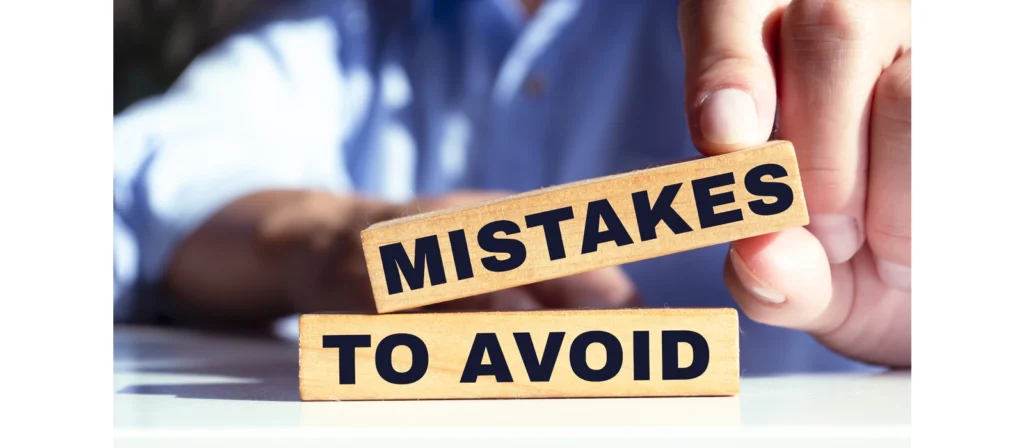
Lack of Physical Space and Equipment
One of the most common obstacles to supporting physical development in early childhood is inadequate space or lack of developmentally appropriate equipment. Many preschools and childcare centers operate in facilities with limited indoor movement areas or underdeveloped outdoor play zones.
Without space to run, climb, or ride, children miss crucial opportunities to build strength, coordination, and confidence. Investment in purpose-built learning environments—with play structures, soft-surface flooring, and open floorplans—is essential. Providers like XIHA Furniture help address this by offering child-safe, ergonomic furniture that supports active, self-directed movement within compact classrooms.
Educator Training and Awareness Gaps
Another challenge is that not all early childhood educators receive sufficient training in physical development. While many teachers are confident in cognitive or language instruction, fewer feel prepared to assess and foster gross and fine motor growth. This gap can lead to underprioritization of movement-based learning or even misidentification of delays.
Professional development programs that include motor development, movement science, and activity design can empower educators to confidently promote physical development in early childhood.
Screen Time and Sedentary Lifestyles
In today’s digital age, children are exposed to screens earlier and more frequently than ever before. Increased screen time correlates strongly with reduced physical activity and slower development of motor skills. Children who spend excessive time seated indoors are less likely to meet physical development milestones aligned with the early childhood age range.
Families and educators must work together to promote active play over passive entertainment and set structured daily limits on digital device use.
Health Disparities and Unequal Access
Children from underserved or marginalized communities often face additional barriers to physical development in early childhood. These may include poor nutrition, lack of outdoor space, unsafe neighborhoods, or limited access to healthcare and physical therapy.
Targeted interventions—such as community-based programs, mobile health services, and inclusive curriculum planning—can help bridge these gaps and ensure every child has equitable access to healthy physical development.
Understanding the common challenges that impact physical development in early childhood is the first step toward overcoming them. Through improved infrastructure, professional support, equitable policies, and product innovation from brands like XIHA Furniture, we can create environments where every child has the opportunity to grow, move, and thrive.
Conclusion
Physical development in early childhood is the cornerstone of lifelong health, learning, and emotional resilience. From muscle coordination to brain stimulation, every movement lays the groundwork for how a child thinks, feels, and interacts with the world. When supported with intention—through curriculum, environment, nutrition, and care—physical development fuels growth across all developmental domains.
At XIHA Furniture, we believe that high-quality, ergonomically designed classroom environments are essential for empowering young learners. Our commitment to supporting early childhood development means providing the tools and furniture that help children move safely, freely, and confidently.
By understanding and prioritizing physical development in early childhood, educators, caregivers, and policymakers alike can ensure every child has the opportunity to thrive—physically, cognitively, socially, and emotionally—in their most critical years of growth.

